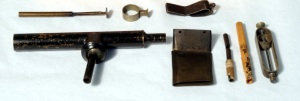RESPONSE #2 Kate Smith
On 24 October D. Graham Burnett (Professor, Historian of Science, Princeton) and Sal Randolph (Artist) led us through practices of attending developed by the Order of the Third Bird. The practice asks participants to stop and attend to an object at hand. Not simply a method of looking, by providing attention, participants are encouraged to focus in on the object in multiple ways. The first stage of the practice takes the form of an encounter with participants entering a particular space and asking ‘what have we here?’ Next, individuals actively attend. They look closely, probing the idea of the object brought to them through their sensory encounter. After this, the practice demands that each individual negate the object, rejecting its presence. Finally, participants return to the object, realizing it and attending to its needs and potentials.
Burnett and Randolph’s session encouraged me to engage again with ideas of object-oriented ontology, which have come to play such an important role in contemporary material culture studies. Here the object has presence, agency and needs. Returning to my own object – Galton’s whistle – this week, and giving time over to its attention, I was struck by it. One of the precepts of the Order of the Third Bird practice is that it is necessary to approach objects without the desire to intellectually frame and interrogate them. Rather in the moments given over to the practice, the object needs to be attended to and given time in which to present itself. Giving such time to the Galton whistle, removing all we know (or think we know about it) I began to consider what it is and what it might be asking of me. The different pieces that make up the apparatus are all unique. Attending to each one in turn I saw how very different these pieces are to my conception of a ‘whistle’. How, I asked, do these pieces fit together? How do they become a working whole capable of making different sounds and pitches? Is this a whistle? How were the different pieces made and by whom? How many pieces are missing? What is absent here? By attending to the object then, finding its gaps and silences, important research questions emerge, providing a juncture in which to begin.

